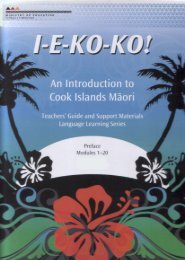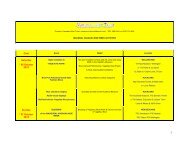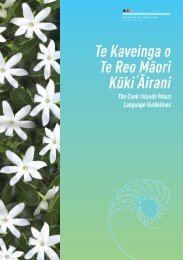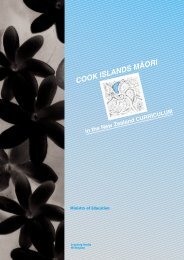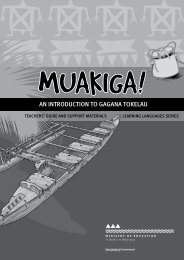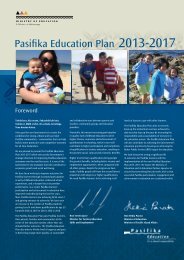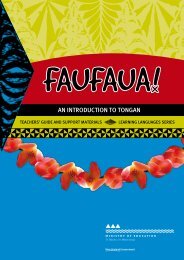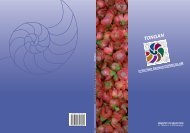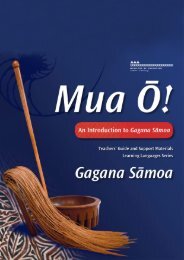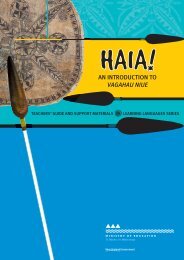Ta'iala mo le Gagana SÄmoa - Pasifika Education Community
Ta'iala mo le Gagana SÄmoa - Pasifika Education Community
Ta'iala mo le Gagana SÄmoa - Pasifika Education Community
You also want an ePaper? Increase the reach of your titles
YUMPU automatically turns print PDFs into web optimized ePapers that Google loves.
Ālāfua 1 – Ola Lau<strong>le</strong><strong>le</strong>iStrand 1 – Well-beingThe health and well-being of the child are protected and nurtured.Young children experience transitions from home to service, from service to service, and from serviceto school. They need as much consistency and continuity of experience as possib<strong>le</strong> in order to developconfidence and trust to explore and to establish a secure foundation of remembered and anticipatedpeop<strong>le</strong>, places, things, and experiences.Te Whāriki, page 46SiniGoalsFa‘ata‘ita‘iga o tomai i <strong>le</strong>i‘uga ‘ua a‘oa‘oinaExamp<strong>le</strong>s of <strong>le</strong>arning outcomesFa‘ata‘ita‘iga o <strong>le</strong> poto māsani ‘uaa‘oa‘oinaExamp<strong>le</strong>s of <strong>le</strong>arning experiences28Goal 1Children experiencean environmentwhere their healthis pro<strong>mo</strong>ted.Goal 2Children experiencean environmentwhere theire<strong>mo</strong>tional wellbeingis nurtured.Children develop:• know<strong>le</strong>dge about how to keepthemselves healthy.Children develop:• confidence and the ability toexpress e<strong>mo</strong>tional needs;• an increasing ability todetermine their own actionsand make their own choices.Children have opportunities to use gaganaSā<strong>mo</strong>a when they are:• singing Tamaiti lāiti tofu ma <strong>le</strong> solosolo, apese that reminds them to blow their noses;• having ear checks or Mighty Mouth visitsor talking about how to keep their teethhealthy, for examp<strong>le</strong>:Nurse: ‘O <strong>le</strong> ā <strong>le</strong> taimi e fufulu ai ou nifo?Child: Pe‘ā ‘uma ‘ona ‘ai.Nurse: ‘Aiseā?Child: ‘Ua <strong>le</strong>aga nifo i mea‘ai;• washing their hands before eating and afterplay and singing Fufulu lima palapalā;• talking about playing outdoors, for examp<strong>le</strong>:Teacher: ‘O ā mea e fai pe‘ā ō ‘i fafo eta‘a‘alo?Child: Fai se‘evae ma <strong>le</strong> pūlou.Children have opportunities to use gaganaSā<strong>mo</strong>a when they are:• engaged in imaginative play, for examp<strong>le</strong>,a child putting a baby doll to s<strong>le</strong>ep may say:Moe la‘u pepe;• settling in, for examp<strong>le</strong>, a child may say:Fia alu i lo‘u mummy;• prob<strong>le</strong>m solving and negotiating, forexamp<strong>le</strong>, one child may say: ‘Aumai la‘uta‘ava<strong>le</strong>, and another child may respond:Lēai, ‘o la‘u ta‘ava<strong>le</strong>;• playing outside with equipment, for examp<strong>le</strong>,a child may say: E mafai ona ‘aumai <strong>le</strong> polo?;• talking about who did something first,for examp<strong>le</strong>, a child may say: ‘O a‘u namuamua mai!;• needing to go to the toi<strong>le</strong>t, for examp<strong>le</strong>,a child may say: Fia alu ‘i <strong>le</strong> toi<strong>le</strong>t.



